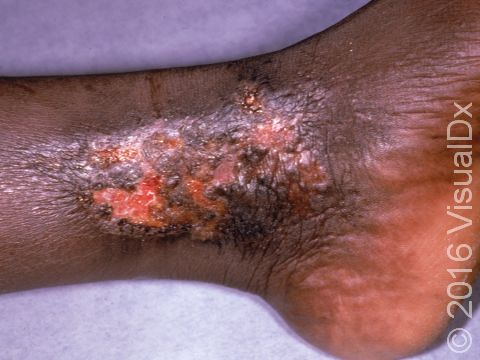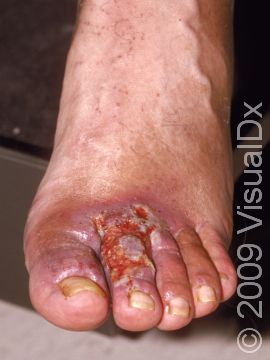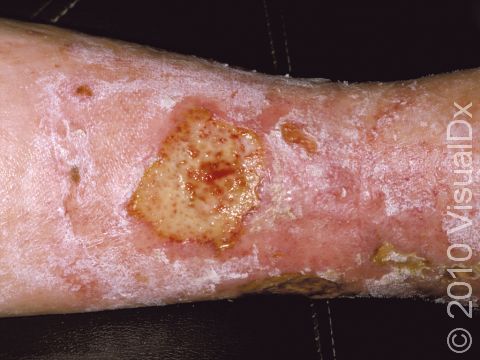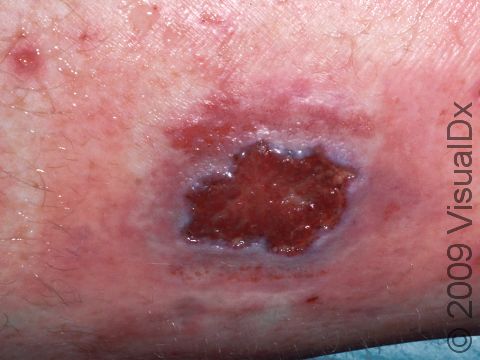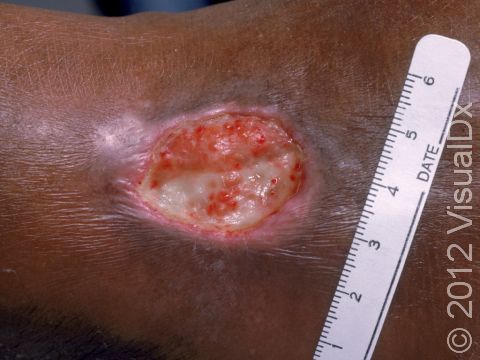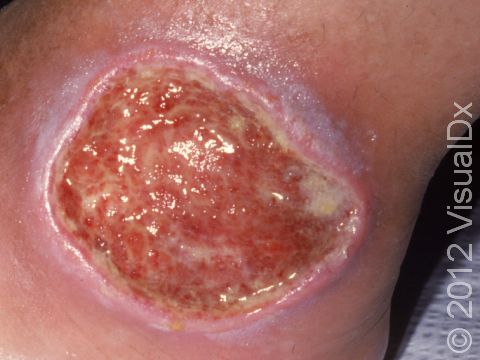Stasis Ulcer
A stasis ulcer, also known as a venous ulcer, is an ulcer (a sore that is missing skin) caused by fluid buildup in the skin from poor vein function, called venous insufficiency. In venous insufficiency, fluid leaks from the veins into skin tissue when the blood backs up rather than returning to the heart through the veins.
Who's At Risk?
Venous insufficiency is most common in older adults and in those with certain underlying medical conditions.
Your risk for acquiring a stasis ulcer is greater if you:
- Are overweight.
- Are pregnant.
- Have varicose veins.
- Have had blood clots in your legs.
- Had a leg injury (trauma) that might affect blood flow in your leg veins; even minor trauma may cause an ulcer.
Signs & Symptoms
Swelling of the leg, brown skin discoloration, or an itchy, red, rough area (stasis dermatitis) may appear before you notice an ulcer. The ulcer is often seen on the inner ankle area first, although any area on the lower leg may be affected. There may be one or more ulcers, and varicose veins may be present. Sometimes there are hard, tender lumps under the skin near the ulcer.
The ulcer is a crater-like but shallow, irregular area of skin loss. It may be an open, easily bleeding, painful wound, or it might have a thick scab. The level of pain varies.
Self-Care Guidelines
Anyone with a leg ulcer should seek medical care if it is anything beyond a small scrape or cut on the surface of the skin.
If the ulcer appears minor:
- Clean it with soap and water.
- Apply a thin layer of petroleum jelly (Vaseline) and a clean gauze bandage.
- Keep the leg elevated when at rest and wear compression stockings.
- Avoid putting any tape or adhesive on the skin.
- Avoid using topical antibiotics and other over-the-counter products, as people with leg ulcers often become allergic to these products.
Treatments
In addition to a thorough examination, your medical professional may do tests to evaluate how well your veins are working.
Treatment for a stasis ulcer may consist of:
- Compression hose to reduce leg swelling.
- Medication for any skin inflammation (dermatitis) or infection that is present.
- Special wound dressings.
- Removing dead tissue with a scalpel (a procedure called debridement).
- Surgery for varicose veins if other medical treatment fails.
Visit Urgency
If you have pain, swelling, spreading red areas, fever, or any open wound that does not heal after a few days of self-care, seek medical care.
Trusted Links
References
Bolognia J, Schaffer JV, Cerroni L. Dermatology. 4th ed. Philadelphia, PA: Elsevier; 2018.
James WD, Elston D, Treat JR, Rosenbach MA. Andrew’s Diseases of the Skin. 13th ed. Philadelphia, PA: Elsevier; 2019.
Kang S, Amagai M, Bruckner AL, et al. Fitzpatrick’s Dermatology. 9th ed. New York, NY: McGraw-Hill Education; 2019.
Last modified on June 18th, 2024 at 4:01 pm

Not sure what to look for?
Try our new Rash and Skin Condition Finder

